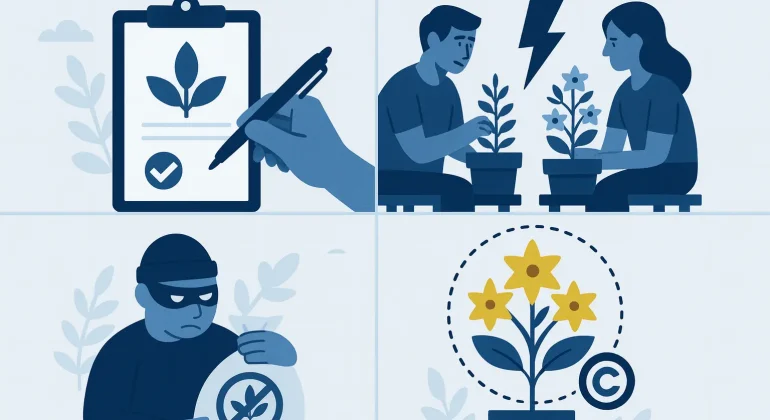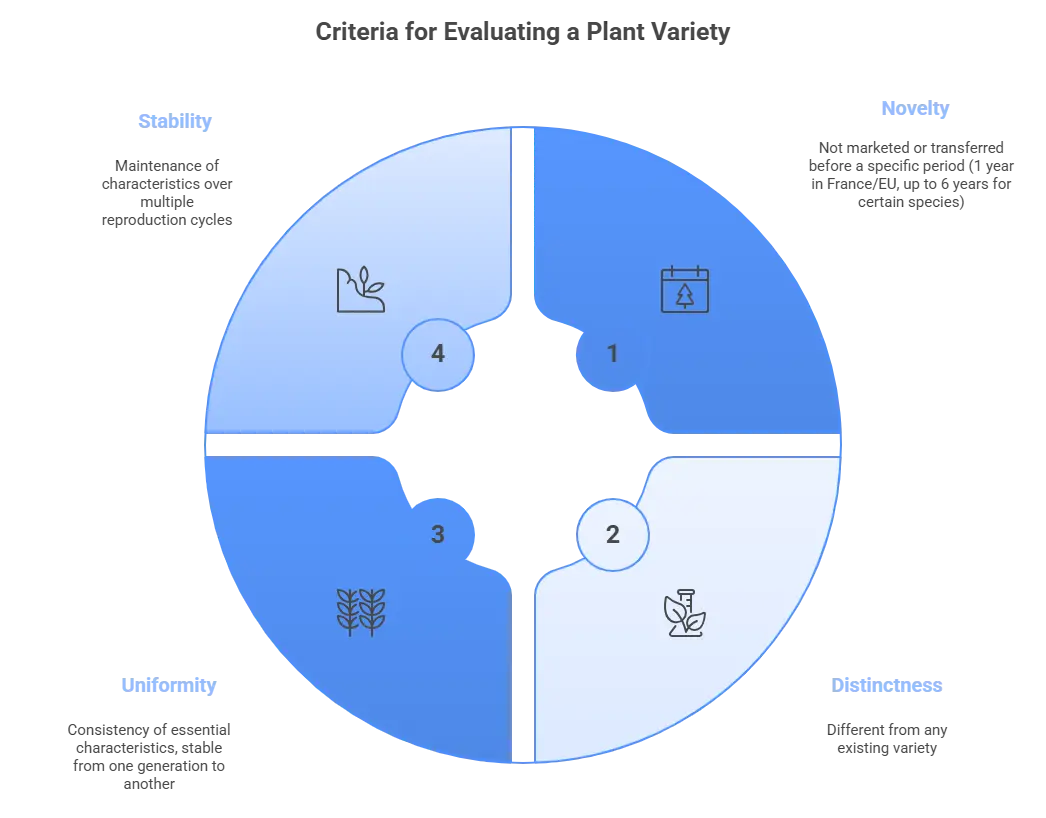Sommaire
- 1 Introduction
- 2 Criteria for obtaining a plant breeder’s right
- 3 Filing procedure and costs for a plant breeder’s right
- 4 Commercial valorization of a plant variety
- 5 Maintaining competitiveness of protected varieties
- 6 Actions and remedies in case of infringement of protected plant breeder’s rights
- 7 Conclusion
- 8 FAQ
Introduction
In a rapidly evolving agricultural landscape, the creation of new plant varieties serves as a strategic tool for food sovereignty, agronomic innovation, and environmental sustainability. These varieties, the result of complex and lengthy scientific work, require tailored legal protection to secure breeders’ investments and ensure the traceability of seeds used in markets. The Plant Breeder’s Rights (PBR), is a form of exclusive right akin to a patent but specifically designed for plant innovations. It is governed by a normative framework harmonized at national, European, and international levels in France, by the Intellectual Property Code, in the European Union, by Regulation (EC) No. 2100/94 and internationally, by the UPOV Convention.
Criteria for obtaining a plant breeder’s right
1.1 Evaluating a plant variety: the four technical criteria
To obtain a COV, a variety must meet four key criteria: novelty, distinctness, uniformity, and stability.
- Novelty: The variety must not have been placed on the market or transferred to third parties within a specified time period. In France and the European Union, this period is one year, but it may extend to four years for non-EU countries, and even six years for certain perennial species like trees and vines.
- Distinctness: The variety must be distinct from any known variety at the time of the application. This distinction is based on one or more significant characteristics, such as morphological, phenological, or performance traits.
- Uniformity: The variety must be uniform in its essential characteristics, meaning its properties must be stable and reproduced consistently across generations.
- Stability: The variety must be stable, meaning its characteristics remain constant through multiple breeding cycles.
All these criteria are validated through DHS tests for Distinctness, Homogeneity, and Stability, carried out by accredited organizations such as GEVES in France.
1.2 A compliant variety name
The deposited variety must bear a name that adheres to the standards set by UPOV. This name must be unique, neutral, and not misleading regarding the origin, nature, or quality of the variety. For instance, it should not contain laudatory terms, trademarks, or unsubstantiated geographical indications. INOV in France or CPVO at the European level may reject a non-compliant name and require the applicant to propose a new one.
1.3 Exceptions and exclusions
Certain varieties are excluded from protection. For example, farmer varieties or those already marketed before the filing are not eligible. Similarly, varieties without genetic traceability or those based on traditional knowledge cannot be protected. Moreover, varieties whose characteristics are already known or those not meeting technical criteria are also excluded from the procedure.
Filing procedure and costs for a plant breeder’s right
2.1 Strategic choice of protection mode: INOV, CPVO, or UPOV
The choice of protection system depends on the applicant’s business strategy. They may opt for national protection via INOV in France, which is ideal for local projects, or for community protection via CPVO, which is valid in all EU member states. Alternatively, an international system via UPOV allows the variety to be protected in several signatory countries, which is suitable for businesses aiming for global expansion.
2.2 Filing steps and technical examinations
The filing begins with submitting a complete dossier that includes a detailed description of the variety, its name, genealogy, and biological samples. Then, DHS tests are conducted to assess the distinctness, homogeneity, and stability of the variety. If the criteria are met, the application is published, and an opposition period is set. After this period ends, and provided no opposition has been raised, the certificate is issued and published in the official Bulletin.
2.3 Fees, timelines, and duration of protection
The filing fees for a COV generally range between 3,000 and 6,000 euros, depending on the species and the required tests. Protection typically lasts for 25 years and can be extended to 30 years for certain perennial species like vines, fruit trees, and potatoes. Processing a request can take between one and four years, depending on the crop and the chosen procedure.
Commercial valorization of a plant variety
3.1 Exploitation methods and seed licensing
The COV grants the holder exclusive exploitation rights over the variety. The holder can choose to produce and sell the seeds directly or license them to third parties. These licenses may be exclusive or non-exclusive, and may include contractual conditions regarding duration, territory, and production volumes.
3.2 Structuring partnerships and royalty mechanisms
Commercial valorization often involves partnerships with producers or agri-food industries, enabling investment pooling and accelerating commercialization. Royalties are typically based on the volume of seeds marketed and serve as a key economic lever to ensure the profitability of breeding efforts.
3.3 Scientific promotion through research projects and niche markets
Protected varieties can also be utilized in agronomic research programs to develop traits such as disease resistance or climate adaptability. This not only enhances their visibility but also promotes their adoption in specialized markets and for export.
Maintaining competitiveness of protected varieties
4.1 Progressive adaptation to climate change and agricultural demands
Varieties must now meet resilience criteria against climate change, while also meeting the demands of sustainable agriculture. Legal protection must be coupled with continuous agronomic evaluation to maintain the competitiveness of varieties in line with evolving agricultural needs.
4.2 Genetic innovation through digital tools and selective breeding regulations
Advances in genetics and the use of digital tools help accelerate the selection process for varieties. The UPOV exemption for selection also allows the use of protected varieties to create new, innovative varieties.
4.3 Developing seed sovereignty for responsible agriculture
The COV also plays a role in seed sovereignty policy by allowing states to reduce their dependency on foreign seeds and promoting locally adapted production that meets specific agricultural and environmental challenges.
Actions and remedies in case of infringement of protected plant breeder’s rights
5.1 Types of infringements
Unauthorized exploitation of a protected variety constitutes infringement. This includes the unlawful reproduction of seeds, unlicensed commercialization, and fraudulent use in a breeding program.
5.2 Civil, criminal, and customs sanctions
Article L623-25 and seq. of the Intellectual Property Code provides for civil sanctions, such as damage compensation, confiscation of infringing batches, and exploitation bans. In case of infringement, the holder can also seek criminal sanctions, with penalties including up to three years in prison and a fine of 300,000 euros, which may be doubled in case of repeat offenses. Customs measures can also be taken to detain illegally imported seeds.
A recent case illustrates these sanctions: in an Italian case, R.G.Dib. 1220/2024 the Tribunale ordinario di Nocera Inferiore sentenced the defendant to six months in prison and a 1,000-euro fine for infringing a protected plant variety, highlighting the severe sanctions against intellectual property violations related to plant breeding rights.
5.3 Enforcement methods for holders
To combat infringement, holders have several enforcement options, such as filing a lawsuit for infringement before the competent court, carrying out a seizure order with judicial authorization, or notifying customs services to activate border control measures.
Conclusion
The Plant Breeder’s Right is a crucial tool for the protection of innovations in the plant sector, ensuring legal security and enhancing the competitiveness of market players. To be fully effective, it is essential to understand the applicable legal framework and implement tailored strategies for valorization and defense against infringement.
Dreyfus & Associés supports plant industry stakeholders in protecting, valorizing, and defending their plant breeding rights in France, Europe, and internationally. Our expertise covers the entire lifecycle of the COV, from filing strategy to infringement actions.
Nathalie Dreyfus, with the support of the entire Dreyfus team.
FAQ
1. Duration of a plant breeder’s right
The certificate is valid for 25 years, or 30 years for certain species (vines, fruit trees, potatoes), with annual fees to maintain protection.
2. Can a patent and a plant breeder’s right be combined?
No, a single variety cannot be protected by both a patent and a COV, but a process for creating a variety can be patented independently of the COV.
3. Technical criteria for obtaining a COV
The variety must be novel, distinct, uniform, and stable, assessed through DHS tests conducted by accredited bodies like GEVES.
4. Reselling seeds from a protected variety
Reselling is strictly regulated. Only license holders or certain farmers can use farm-saved seeds; otherwise, it constitutes infringement.
5. What to do in case of infringement?
The holder can file an infringement action, request a seizure order, seek an injunction, or activate customs detention. Civil, criminal, and customs sanctions may apply.


